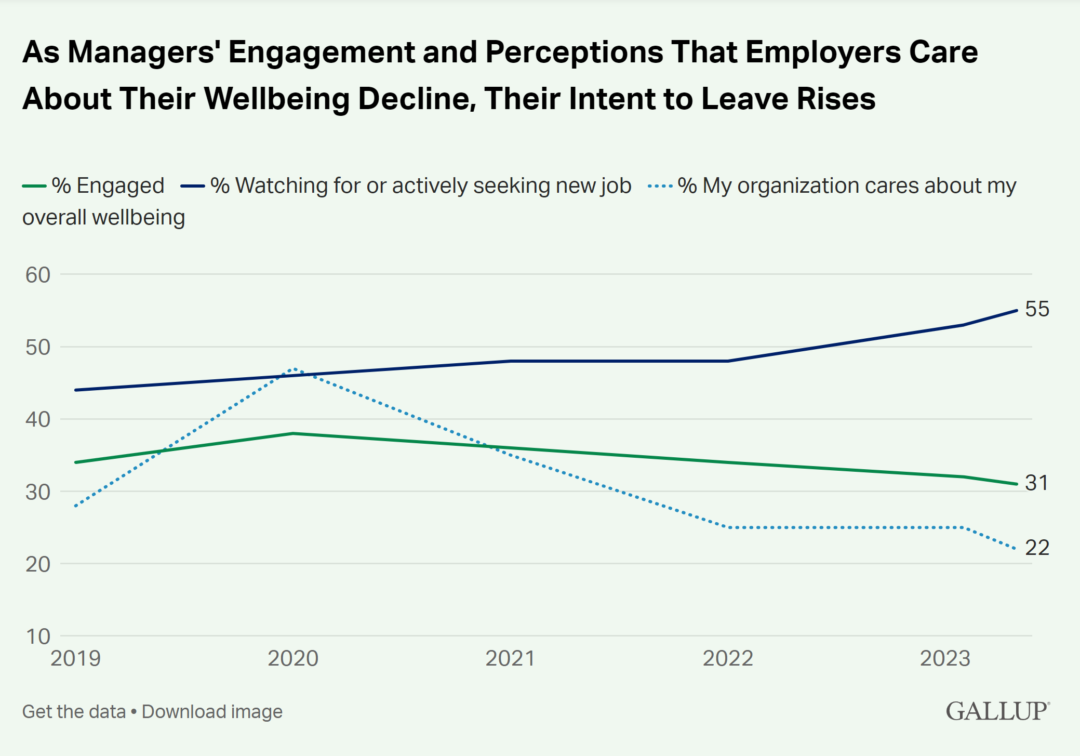How to Prevent a Coffee Badging Bonanza at Your Workplace

Coined in 2023, one of The Times’ 2024 buzzwords of the year and making the news today – coffee badging has become an observable phenomenon. And it’s even more relevant with the flurry of full time RTO mandates over the last few months.
In this post, we’re taking a look at the definition of coffee badging, why people do it, its impacts and how to prevent a coffee badging bonanza from cropping up in your workplace.
What is coffee badging?
Coffee badging is when employees swipe their badge to get into the office, get a coffee and then leave shortly afterwards. This is usually done in response to hard line return-to-office mandates. The intent is to be seen as complying with mandates without spending the whole day in the office.
A July 2024 paper on the post-pandemic workplace defines coffee badging as “The recent practice of employees who ‘show their faces’ at the office for a super brief period of time, about as long as it takes to grab a cup of coffee, before heading out. The trend is widespread, and is an indication of employee dissatisfaction at work, poor organizational culture, and certainly a degree of rejection of employers’ remote and strict hybrid work policies.”
58% of US employees admitted to coffee badging in 2023, dropping down to 44% last year. 39% of employees in the UK and 38% in Germany also came clean about their coffee badging.
“Coffee badging is a clear indicator of dysfunction in a workplace,” says John Frehse, head of global labor strategy for consulting firm Ankura.
Given this, what goes through people’s heads as they coffee badge? Why do they do it?
Why do employees coffee badge?
People coffee badge because they perceive being in the office as a waste of time. Office attendance is done for appearances only and kept to a minimum, so people can continue working from home where they feel they’re more productive. That way, employees follow the rules without risking disciplinary consequences.
Says one redditor on coffee badging, “I’m so glad what I do when I go into the office has a name now. I just assumed it was my privilege to get to go into the office for 45 minutes twice a week.”
Another in r/economics says, “AMA, I’m a coffee badger. I’m supposed to be fully onsite 5 days a week. Usually that translates to one to two actual full days in office to appease overlords during attendance sweeps, or when visibility is needed, and then I coffee badge whenever possible the remainder of the week so I can go home and do systems modelling in peace, just like I used to do perfectly fine when I was fully remote. I work in an open office with zero walls that averages around 70dB at any time of day.”
We can conclude that there’s three main reasons people coffee badge:
- Because they’re complying with an RTO mandate they think is pointless and/or unfair
- Because bonuses and performance reviews are based on office attendance
- Because the work environment isn’t conducive to getting anything done.
Deloitte has recently joined the ranks of companies incorporating office attendance in to performance reviews. PWC has stated it will track in-office time in the same way it tracks billable hours.
After making headlines for mandating employees back into the office full time, turns out JPMorgan doesn’t actually have enough desks for everyone, let alone the space for people to work comfortably. “There definitely aren’t enough desks for everyone so people have to hope others are taking PTO that day to get a seat,” according to anonymous employee. “The office is loud, crowded, and overall not an enjoyable place to be,” another commented.
If getting a raise or promotion depends on people seeing you in the office, but there isn’t the space or the atmosphere to get any solid work done, coffee badging is a no-brainer.
But what are the downfalls? And are coffee badgers really symptomatic of a dysfunctional workplace?
The consequences of coffee badging
Unproductivity.
Working for appearances only doesn’t lead to any meaningful outcomes or results. In this sense, coffee badging is literally the definition of busy work, save for any boosts in social connection that happen while you chat to a colleague as you wait for the espresso to drip into your mug.
Over a third of employees report that busy work makes up almost half of their day. That’s a lot of hours spent treading water instead of getting things done efficiently and problem solving.
But where does the blame for unproductivity lie here? Ultimately with the employer for creating an appearances-based culture, as nebulous as culture is.
“For employers who value the perception of a full office over actual productivity, coffee badging is the inevitable result,” writes the Guardian.
Employee unengagement.
Busy work has more consequences that unproductivity, namely feeling unenthused about what you’re doing and potential burnout. The result of both is disengaged employees, which already costs $8.8 trillion per year.
Damaged workplace wellbeing.
Feeling monitored leads to stress and anxiety. Monitoring based on how many times you show up at the office is also evidence enough that your organization cares more about control than employee wellbeing.
The percent of employees who believe their employer cares about their wellbeing is at an all time low, according to Gallup.

Notice the spike in 2020 when remote and hybrid work were introduced, followed by the steady drop off since then. Interesting coincidence.
Increased churn.
The percentage of employees actively or passively looking for a new job rises as perceptions of employer investment in wellbeing falls. We’ve already seen that hard line RTO mandates trigger a mass exodus, and coffee badging as a reaction to mandates is a sign that putting in notice will be the next thing to occur.
Not enough workplace data.
If people are coffee badging, your occupancy data might tell you everyone is in for the day, when everyone is decidedly not. Unless an organization takes the Amazon route and requires employees to badge swipe when they leave the premises, workplace leaders will be in the dark about overcrowding. As a result, there’s not enough data to even guesstimate the right numbers, types and configurations of spaces, let alone improve the workplace.
The cycle of showing up and badging in because you’re forced to, seeing that there’s not enough desks and then leaving is now doomed to continue in perpetuity.
5 Office Space Utilization Metrics for a Better Workplace in 2025
Space utilization measures how effectively space is being used, so you can create a workplace people want to spend time in. Here are five metrics to start measuring.

Three ways to prevent a coffee badging bonanza at your workplace
1. Don’t implement hard line RTO mandates.
This one’s an obvious one but it’s worth saying again. Coffee badging is a response to an employer deciding where you should work while preserving your autonomy and productivity – without the risk of getting reprimanded.
Even if executives want employees in the office a minimum number of days per week, providing guidance and giving teams the autonomy to decide their own schedules is a far more productive approach. And speaking of productivity, a recent study found that working from home improves productivity for public sector employees by 12%.
2. Make sure management is practicing what they preach.
A quick browse of Reddit and Quora reveals that people think coffee badging is exactly what the C Suite has been doing for decades. Walking into the office later than everyone else, sitting behind a closed door for an hour, heading out for a lengthy executive lunch (did that lunch include martinis?) and then heading off early is just perceived to be another day in the life of a CEO, according to many.
So if your organization is going to provide guidelines or mandates for people to badge in for a minimum number of days, make sure every manager is spending full days in the office. Anything less than that will be perceived as hypocrisy.
3. Make the office worth people’s while.
When people come into the office, they’re sacrificing the time it takes to commute there and back, convenience and control over their work environment. What are they getting in return? Are they getting back more than what they’re putting in? If the answer is no, prepare for a coffee badging bonanza.
So at the very least, commuting reimbursements are a must. A quarter of employees surveyed by Owl Labs said these kinds of reimbursements, plus more privacy and subsidized food could make them decide to spend more time in the office.
Another bare minimum criteria for making the office worth people’s while is having enough desks and meeting rooms. This is where occupancy data comes in, so you can analyze how close floors and neighborhoods are coming to capacity when everyone is in.
Most, but not all, feel they’re more productive when working remotely. So coming into the office needs to deliver something more than what people can get at home if you want to increase attendance without slapping on mandates. Plan collaborative activities and social gathering at a company or team level to draw more people in. This also has the upside of boosting connection plus strengthening existing and new work relationships. Atlassian’s employees reported a 96% boost in satisfaction and a 27% increase in team communication after in-person meet ups.
The bottom line is that if you want people to spend more time in the office, you have to give before you take.
But what should you give?
Webinar: Look Beyond Mandate Wars and Drive Purposeful Togetherness
How do you get more people into the office without slapping on mandates that cause an onslaught of coffee badging? Check out this on-demand webinar to find out.

Share this post
You might also like


















